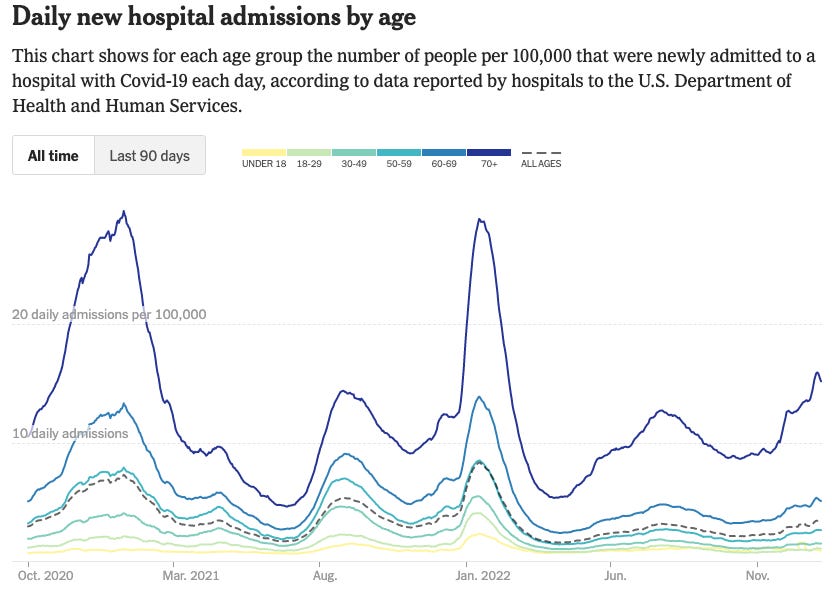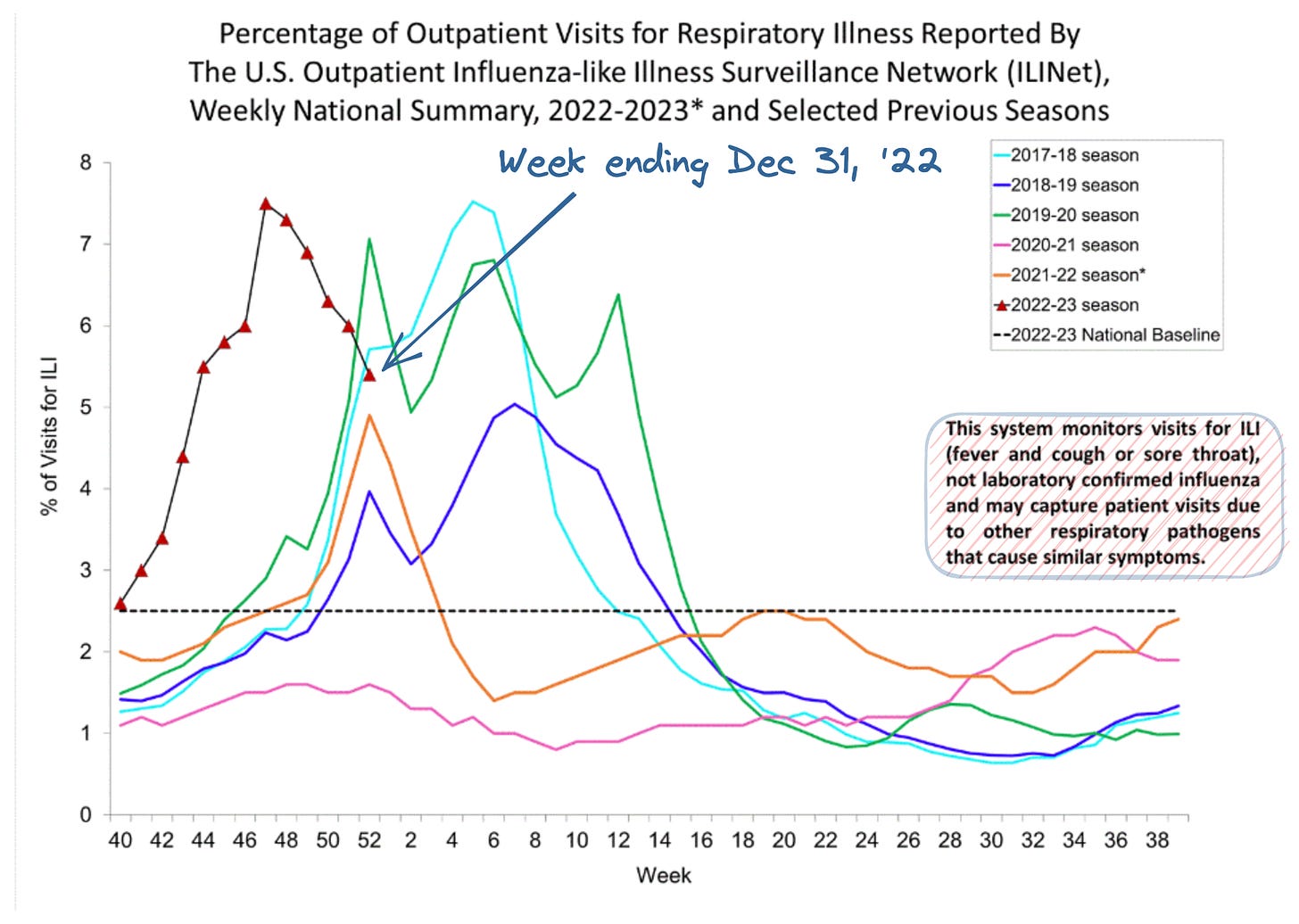I’m proud to share that Force of Infection is now one of the top Science publications on Substack. In the past six months, I’ve analyzed the mpox (formerly monkeypox) epidemic, teamed up with
to warn of what became the tripledemic, untangled claims that children need exposure to pathogens to develop healthy immune systems, and more. Based on reader feedback, I am also now covering more “news you can use” about pathogens like RSV and influenza that most often impact our daily lives. Thank you all for your support! If you are enjoying this publication, please subscribe and share.Respiratory diseases
Summary of trends:
COVID-19: ↗️
Norovirus: ↗️
ILI: ↘️
RSV: ↘️
Seasonal coronaviruses: ?
This week, COVID-19 is kicking influenza-like illness off the front page of Force of Infection. There are more than twice as many people in the hospital for COVID-19 than influenza, and the gap is likely to grow as flu season recedes.
I no longer consider cases to be a reliable indicator. The widespread availability of at-home testing (plus what I suspect is an overall decline in interest in testing) has made case counts uninformative. Instead, I am using hospitalizations, wastewater and, to a lesser extent, test positivity, to judge the latest trends.
TIP: Need more COVID-19 home tests? You can order four free tests from USPS. Private health insurers are also required to reimburse for up to eight tests per person per month, so a family of four could receive 32 tests per month for free. I have had good experiences ordering through CVS. [Note: a previous version of this newsletter said the benefit was six tests. It’s actually eight.]
COVID-19 hospitalization have been increasing steadily since November. As of January 6, 48,000 were hospitalized with COVID-19, the highest it has been since February of 2021. As in previous waves, older adults remain most at risk of hospitalization, especially people over the age of 70.
Admissions in older age groups have slowed in the last few days, which is perhaps a hopeful sign.

States in the Mid-Atlantic and New England regions have the most people hospitalized per capita. I’ve noticed that new waves often start in those regions, then move to the South and Midwestern regions before reaching areas west. Wastewater data agrees: the New England region has the highest viral concentration, followed by the South. However, there are declines in wastewater concentration in both the New England and Midwestern regions, another hopeful sign.
On the bright side, influenza like illness continued to fall for the fifth week in a row.

The number of people hospitalized with influenza in the week ending Dec 31 has dropped to under 19,000, down from a high of 26,000. However, the number of hospitals submitting data has also dipped in recent weeks, so I’m taking that assessment with a grain of salt.
Thirty-nine jurisdictions are now classified as having high or very high levels of ILI activity, down from 44 jurisdictions last week. ILI activity is highest in Maine, Massachusetts, New Mexico, and New York City. I did notice some rebound in state and local data, including increases in some respiratory disease indicators in Chicago, Texas and Alabama, so I’ll be keeping eye on that.

The CDC released preliminary estimates of the burden, or impact, of influenza for the October through December period. Epidemiologists estimated that were between 22 and 43 million flu illnesses, 230,000 to 490,000 hospitalizations, and 14,000 to 43,000 deaths. This is comparable to an average flu season—though this season began earlier, and the peak week was higher than normal. CDC is likely to publish preliminary estimates of the seasonal flu vaccine’s effectiveness soon; this year’s match is expected to be good.

RSV activity continues to fall.
According to CDC data, the seasonal coronaviruses may have let up a bit in the last reporting period—but data from Georgia and Biofire tell a different story, so it’s too early to call it a trend. There are seven known human coronaviruses, three of which can cause severe illness: Covid-19, SARS, and MERS. The other four mostly cause mild, cold-like symptoms and circulate regularly. Two of these mild, seasonal coronaviruses are currently on the rise. Rhinovirus, another cause of the common cold, also seems to be ticking up.
Stomach bugs
In a continuation of a trend I’ve been reporting for months now, norovirus (the classic “stomach bug”) is surging. This is most evident in the midwestern and western regions of the country, where the percentage of tests that are positive for norovirus is above 10%, up from 4-8% over the summer months. (Have more data for me? Reply to this email!)
More on preventing the stomach bug: Norovirus spreads very easily between people through the “fecal-oral” route. To stop it from spreading, wash your hands thoroughly after using the bathroom and before eating or preparing food. I also use hand sanitizer while I’m in public like after I use self-checkout at the grocery store or when I use public transportation, but you should know that hand sanitizer is not as effective against norovirus as hand washing. Be sure to wash your hands properly when you get home. Most importantly, stay home if you have vomiting or diarrhea.
If someone in your household gets norovirus, you can reduce the chance it will spread by keeping them out of the kitchen and disinfecting contaminated (read: bathroom) and shared surfaces. Also regard laundry like bedsheets, clothes, and towels as contaminated. Use gloves when handling the items and wash them thoroughly with hot water on the longest cleaning cycle.
Food recalls
The following foods are being recalled because they are contaminated with bacteria that causes food poisoning. Please check your cupboards and throw out any of these items:
New this week:
None!
Previously reported:
Frozen manicotti by Caesar’s Pasta, sold to restaurant distributors in Pennsylvania, New York and Puerto Rico (more info)
Raw, frozen diced beef sold by Morasch Meats (more info)
Whole Nutrition Infant Formula, Milk Based Powder with Iron for 0-12 months (more info)
James Farm frozen raspberries sold through Restaurant Depot/Jetro (more info)
Kraft ready-to-eat ham and cheese loaf products (more info)
Nestle edible Chocolate Chip Cookie Dough tubs with best-by dates of January 28-30, 2023 (more info)
There is also a multi-state outbreak of Listeria linked to deli meats and cheeses, but the specific source has not been identified. If you are pregnant, over the age of 65, or have a condition that weakens your immune system, consider avoiding meat or cheese from deli counters. (more info)
If you have food allergies, you may wish to review these FDA safety alerts for foods with undeclared allergens.
First aid
The shocking collapse of Damar Hamlin on the football field last week reminded me of the importance of staying up to date on basic lifesaving skills. Hamlin, who suffered a cardiac arrest, was revived by first responders and is reportedly recovering. In light of this event, I took a few minutes to watch videos on:
measures to stop severe bleeding
aiding someone who is choking
recognizing drowning (it’s more subtle than you think)
It seems like a long list, but the videos are only 2-5 minutes each. I hope you’ll find some time to review these important lessons. Also note that CPR and choking procedures are different for infants, so if you have small children in your life, please look up specific instructions for them.
If first aid skills are new to you, I recommend taking an in-person class. Most community centers offer classes for free or at a low cost. Don’t skimp on these valuable skills—they could make all the difference.





Love these posts. Is there a way to compare hospitalizations across these diseases by age to get a sense of relative risk at a particular time? Curious for young kids or older adults how flu, rsv, and Covid compare.